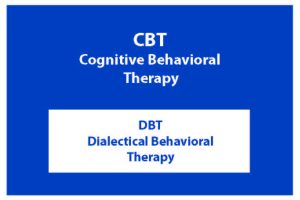CBT VS DBT
The Difference Between CBT and DBT (Cognitive and Dialectical Behavioral Therapies)
 Stacey L. Spencer, Ed.D.
Stacey L. Spencer, Ed.D.
Clinical Neuropsychologist, Lindner Center of HOPE
EMDR Trained therapist
Assistant Professor, Department of Psychiatry & Behavioral Neuroscience
There are many, many possible types of psychotherapy. Psychotherapy is an optimal treatment method for mental illnesses. Cognitive Behavioral Therapy (CBT) and Dialectical Behavioral Therapy (DBT) are among the most common psychotherapies.
What is Cognitive Behavioral Therapy?
One that has been in the public sector for decades, and that you’ve likely heard of, is Cognitive Behavioral Therapy (CBT). If you’ve ever gone to therapy, it’s very likely that the therapist you saw practiced CBT. This therapy, also called talk therapy, helps people better understand how thoughts influence our feelings. The goal of CBT is to talk through problems and help frame thoughts differently. CBT is typically time-limited and there are specific goals and homework provided. You might start out with a situation that troubles you, or one you may find troubling. With the guidance of the therapist, you identify the thoughts around the situation and work on finding alternatives and ultimately changing the behaviors in order to feel better. So, it’s thought-feeling-action-focused. Some mental flexibility is involved given that most of these thoughts are automatic and can become engrained.
Cognitive Distortions are often discussed in CBT. CBT helps us to break up negative thought patterns or “thought traps” that can lead to feelings of anxiety, depression and cause us to avoid. A technique to help one move away from this type of thinking and often employed in CBT is “cognitive shifting”. With the help of awareness in what a person focuses on (in this case, often the negative cognition/thought/belief) the idea is that this helps us learn to shift our focus to something more helpful or innovative. There are many Cognitive Distortions under this umbrella. Examples of catastrophizing could be magnifying or minimizing. I read a good description once of this being a “billowing cloud of everything can go wrong” and believing it inevitably will. Or in Minimizing when we downplay our successes.
A CBT-oriented therapist might give someone who tends to catastrophize events in their lives, leading to anxiety, for instance, a worksheet and walk through the process with them. This is hypothesized to have evolved as a way to help us survive during the immediate crisis. Now that we have developed higher-level reasoning skills, this can turn against us, as these negative thoughts can turn sticky.
One way to start is to help the client identify what they are currently most worried/anxious about. The client might start by specifying what they imagine will occur without using “what if” statements. Instead, the focus is on the client’s own predictions, e.g., “ I will fail the exam and get kicked out of school.” You ask the client to rate how much they believe this to be true from 0-100%. Next, the client is asked to take a step back and consider the likelihood of the catastrophe to occur. By helping the client to take a step back and assess the fear from a different perspective and re-interpret their concerns, this is called “reframing”.
Working on ways to cope with and manage these fears/anxieties by not diving into them is a strategy that CBT therapists employ. It takes practice and yet studies have shown that finding more balanced ways of managing these types of thoughts can lead to better mental and physical health outcomes. By helping the client to explore the underlying thoughts, emotions and beliefs and problematic thinking, they can work towards a more balanced view of themselves. The hope is that by helping the client change their perception to support more positive thinking, they will reduce distress and suffering and lead a more fulfilling life.
To recap, CBT features the following:
- Treats emotional response
- Is time-limited
- Works best with solid therapist-patient relationship
- Relies on the application of logic and reason
- Employs structure to guide tailored treatment
What is Dialectical Behavioral Therapy?
Dialectical Behavioral Therapy (DBT) comes from dialectical theory and is actually a type of CBT. DBT posits balance; not leaning too hard in one direction or another. This modality was originally created by Dr. Marsha Linehan in her work with people with chronic life-interfering behaviors, like self-harm and chronic suicidal thoughts. It has expanded to help with many other issues. Dialectical Behavioral Therapy techniques utilize individual therapy, group skills class and coaching. Groups emphasize learning specific DBT coping skills and there is homework given in-between to reinforce what was learned.
DBT Coping Skills
The four pillars of DBT coping skills include:
Mindfulness
Emotion Regulation
Distress Tolerance
Interpersonal Effectiveness
Mindfulness is a DBT coping skill that involves living with intentional awareness of the present moment. This includes not trying to push away or reject the moment but to notice it and not attach ourselves to it. As Dr. Linehan describes, this is by “Attending to the experience of each new moment, rather than ignoring the present by clinging to the past or grabbing for the future.” This takes practice and patience and can take many forms. Some examples of mindfulness include meditation in the form of noticing by either opening or focusing the mind. Contemplative prayer (in any spiritual form) is another mindfulness practice along with mindful movement such as yoga, martial arts, hiking, tai chi.
Emotion Regulation involves understanding and naming one’s emotions. By helping to learn to identify emotions, one can hope to gain an understanding of what they do for us. Goals of this are to decrease the frequency of unwanted emotions, the vulnerability to them and decrease emotional suffering.
Distress Tolerance are DBT coping skills for when involved in a crisis situation and the goal is to not make the crisis worse. By utilizing skills of Radical Acceptance, one can achieve freedom from suffering and being “stuck”. This can help by reducing acting on intense emotions and tolerating painful events. These are only utilized in a crisis situation, where the event or experience is highly stressful and short-term.
Lastly, Interpersonal Effectiveness skills are to help assist with either strengthening current relationships or end destructive ones, to learn to say yes/no effectively, resolve conflicts before they get overwhelming and create and maintain balance in relationships.
The Difference Between CBT vs DBT in Treating Certain Illnesses
Not all mental illnesses respond to treatment in the same way. The difference between CBT and DBT must be taken into consideration when determining the optimal treatment method for an individual. CBT has been shown to be effective when treating depression, anxiety, obsessive compulsive disorder (OCD), phobias, panic disorder and post-traumatic stress disorder. DBT was created to help people who might be easily dysregulated and tend benefit from learning ways to self-soothe, communicate more effectively with others and find ways to reduce significant distress.
The Difference Between CBT and DBT Treatment Methods
The difference between CBT and DBT are defined. CBT focuses on the connection between thoughts, feelings and behaviors and how they influence each other. DBT emphasizes regulating emotions, being mindful and tolerating the uncomfortable. CBT guides patients to recognize troubling thoughts and redirect them, while DBT helps patients accept themselves, feel safe and manage emotions to avoid harmful behaviors.
When comparing CBT vs DBT, both therapies have aspects of how our thinking influences our emotions and behaviors but are different in their approaches and structure of the therapeutic process. Both modalities are evidenced-based, that is, much research has gone into showing whether they are effective. When choosing a therapist, as important as it is to find someone in-network or with openings, it’s equally so to know what treatments are most effective for the reasons you’re seeking therapy in the first place. Therefore, asking about CBT vs DBT and which one might work best for you, would be an important next step in this process. This is the best way to determine if CBT vs DBT are right for you.
Knowing your diagnosis is key to determining what therapy will be most effective for you. However, many people have more than one diagnosis, and sometimes people use a blend of therapy elements to best manage symptoms.
It can be confusing to know what techniques will best help you. CBT and DBT are some of the more common therapy practices, and have been shown to help individuals suffering from a number of mental illnesses.
Choosing to take care of your mental health is just as important as your physical health and finding providers that utilize evidence-based practices will provide you with the best outcomes possible.
For more information about DBT skills group at Lindner Center of HOPE.
